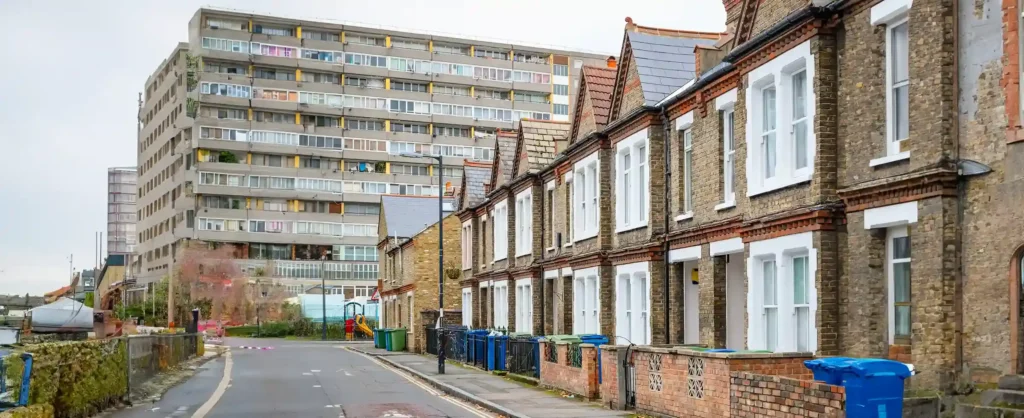With a homelessness and rough sleeping crisis gripping the UK, it should come as no surprise that temporary accommodation is under a tremendous burden. Once seen as a stopgap social housing measure to provide vulnerable individuals with shelter and safety in difficult times, temporary accommodation has since compounded into something entirely different.
With recent figures from The Guardian and the Local Government Association (LGA) showing that England’s local councils are currently paying as much as £1.7 billion a year to keep people in temporary accommodation, the number of households currently living in temporary housing has risen by a dizzying 89% to reach the highest total since records began in 1998. Worse still, a recent report by housing charity Shelter has revealed a range of damning statistics about the state of temporary accommodation in the UK, with highlights including:
- 61% of households living in temporary accommodation have spent a year or more there
- 30% of households have lived in three or more temporary accommodation properties, with 62% being given less than 48 hours notice when moving between placements
- 27% of households were placed in temporary accommodation more than an hour from their previous home
- 26% of households living in temporary accommodation waited more than eight weeks for an urgent repair
- 87% of households living in temporary accommodation struggle to keep up with their costs
- 66% of those living in temporary accommodation report that it negatively impacted their physical and mental health
Even discounting the excessive wait times for a permanent social housing placement, temporary accommodation in the UK is clearly suspect to a litany of issues that make it a gauntlet for the average displaced household at a time when many will already be dealing with other social, systemic or economic challenges that have put them in a position of vulnerability. It may even have an entrenching effect on certain families, making it all the more difficult for them to rebuild their lives. And, with local councils across the country struggling under the budgetary strain of an overreliance on temporary accommodation, it seems just as clear that a solution to the problems at the root of the temporary accommodation system will need to be addressed as quickly as possible.
Although 150 local council representatives recently attended a summit to urge immediate government action on the issues with temporary accommodation, the answers may not be so forthcoming. Does the responsibility for fixing temporary accommodation lie solely with government forces? And if not, what can we as a nation do to more permanently ease the country’s financial and social burden?
The Vicious Cycle of Homelessness and Temporary Accommodation
To reach the most informed decision on how temporary accommodation can be returned to a more sustainable state, it is crucial to understand the relationship between temporary accommodation and homelessness.
For many low-income and vulnerable individuals, 2023 has been a turbulent year. With no-fault evictions by private landlords hitting a seven-year high in the wake of the Renters Reform Bill being delayed and the number of homeless households rising by 4.8% in 2023, an estimated quarter of a million UK households are now experiencing the worst forms of homelessness. In London alone, rough sleeping has risen by 21% since last year, with a further 26% rise in the number of people sleeping rough for the first time. Projections even indicate that as many as 60,000 London renters could be forced into homelessness by 2030 without an increase in housing support.
Despite an obvious systemic demand for housing solutions for this nationwide rise in homelessness, a recent article from the Guardian has shown that an increasing number of temporary homes are being lost to the private sector. London councils reported a 120% year-on-year rise in requests for the return of properties being used as temporary homes back in April this year. This coupled with a 41% reduction in the number of London properties for private rent since 2020 has led to a staggering 781% increase in the number of homeless families being placed in bed-and-breakfast-style accommodation beyond the legal six-week limit.
With temporary accommodation struggling to keep up with the rate of homelessness in the UK, it follows that fewer households at risk of homelessness will be allowed to correct their course through temporary housing. Likewise, those currently living in temporary accommodation will not only have to contend with the poor quality and distress mentioned previously but also the lack of suitable options for meeting their specific needs due to 79% of local councils lacking sufficient temporary accommodation to meet current needs. This will likely only worsen their circumstances and make it harder for them to acclimatise if or when they return to the private or social housing sectors.
As suggested, while the original intent of temporary accommodation was to provide a social safety net for vulnerable individuals, its current state only seems to deepen poverty and housing insecurity, all while homelessness becomes an increasingly looming threat – a vicious cycle of hardship. And, given that the current cost of propping up temporary accommodation would provide enough capital to build 100,000 new homes over the next five years, it is becoming more difficult to justify its current social impact by the day.
How Social Housing Comes Up Short
With a continued lack of social housebuilding preventing long-term solutions to the rough sleeping epidemic, temporary accommodation has been forced to shoulder the burden of rising homelessness to its detriment as a system.
Much like temporary accommodation, the social rented sector of housing has higher levels of overcrowding, frequent forced moves and a waiting list that has left one in ten social renters in housing limbo. It has also been losing homes to the private rented sector just as rapidly with less than 7,000 built and 29,000 lost in 2022. On a regional basis, most local authorities have failed to build even a single home in the past five years, leading to what The Independent describes as ‘social housing paralysis’
Committing more time and money to developing social housing will be instrumental in reducing the strain on temporary accommodation and providing a long-term solution to homelessness. Doing so will require an unprecedented level of social housing investment from both the private and public sectors, however. As a study by researchers at University College London has evidenced, significant investment in social and affordable housing could save the UK government an estimated £1.5 billion a year by eliminating the overwhelming costs associated with homelessness, including overspending on temporary accommodation.
Where Do We Go From Here?
While the systemic issues plaguing temporary accommodation are deep-set and tied to similar issues in the social housing and private rental sectors, answers are not as enigmatic as they might appear.
For example, prolonged tenures in temporary accommodation are a well-publicised practice that can be harmful for everyone from the UK government to the homeless. Investing more heavily in social housing development and brokering partnerships with government-approved private sector providers of rental housing could provide an easier route for filtering tenants who have been in the temporary accommodation system for more than a year into housing that better suits their long-term health and well-being while also freeing up more space for those who are in more dire and immediate need of temporary accommodation.
Committing to a more people-centric and hands-on style of tenancy and property management is also a key change that could massively improve the state of temporary accommodation. Vulnerable individuals often require additional attention and care, so the wrong approach could significantly worsen their already precarious position. Increased scrutiny and regulation over temporary accommodation managers could ensure faster and more thorough rehabilitation by making them feel seen, heard and secure in their short-term housing. This can be especially true in the case of children, who are often the most heavily impacted by inconstant housing.
Finally, seeking out non-traditional alternatives to housing could take advantage of the speed and efficiency of modern methods of construction to create a greater number of homes in a shorter time frame for less. For temporary accommodation and social housing purposes, these homes could be more readily tailored to the needs of vulnerable individuals and their families, offering a degree of flexibility that avoids the trappings of the current temporary accommodation system.
At Concept Capital Group, we specialise in the use of modular homes to combat the housing crisis. Through the controlled, standardised methods used in modular construction, we can produce consistently high-quality buy-to-let homes using sustainable materials and an eco-friendly internal supply chain. Designed to offer comfort and stability to vulnerable individuals, our affordably-priced homes also provide investors with a highly accessible source of fully owned, fully managed passive income with an ethical spin. To find out more about how we redefine social housing while keeping things simple, contact our team today.













